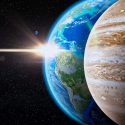The Solar System might not be as quiet and orderly as we think. Imagine one day looking up and seeing something strange in the sky, a small speck that grows larger and larger. Soon, it becomes clear: a new planet, bigger than Earth and possibly as massive as Jupiter, is barreling toward us. This mysterious visitor isn’t just a stunning celestial sight, it’s a potential doomsday scenario.Let’s break down what could happen if a new planet entered our Solar System—and why it might be the end of life as we know it.
Storms, Tides, and Total Chaos
As this massive rogue planet approaches Earth, the first sign of trouble would come from its magnetosphere (the magnetic field surrounding it). Its interaction with Earth’s own magnetic field would spark violent thunderstorms and produce dazzling auroras in the sky. Beautiful, yes. But fleeting.
Next? Earth’s oceans would rise in response to the planet’s immense gravitational pull, creating tidal waves that dwarf anything we’ve seen before. Earthquakes would erupt worldwide. The atmosphere? Slowly siphoned away into space. Soon, the planet would begin to break apart, piece by piece.
Darkness. Cold. Silence. Humanity, along with every other living thing would be wiped out.
How Could This Happen?
To understand the possibility of a new planet, we need to know where our current ones came from. About 4.6 billion years ago, our Solar System formed from a swirling cloud of gas and dust. Over time, tiny particles collided and clumped into planetesimals, and eventually, full-fledged planets.But could new planets still form from leftover material?
Not anymore. The Sun’s solar winds cleared out the remaining gas and dust within the first 10 million years. So any new planet we discover wouldn’t be newly formed, it would have to already be out there.
Is Planet Nine Out There?
Scientists have theorized the existence of Planet Nine, a possible Neptune-sized planet lurking far beyond Pluto. It’s never been directly observed, but its gravitational influence might explain strange orbital patterns among icy objects in the Kuiper Belt.
If it exists, Planet Nine is no threat, it would be 400 to 800 times farther from the Sun than Earth and takes 10,000 to 20,000 years to complete one orbit. Future observatories, like the Vera C. Rubin Observatory, may help confirm its existence.
Beware the Rogue Planet
If new planets can’t form here, could one wander in?
Enter the rogue planet, a planetary body not bound to any star. These celestial nomads may have been ejected from their original solar systems or failed to form stars themselves. Some estimates suggest there could be billions of rogue planets in our galaxy.
If a Jupiter-sized rogue planet wandered into our Solar System, even getting within 3 million km (2 million mi) of Earth could wreak havoc. Its magnetic field and radiation would disrupt Earth’s atmosphere. Tidal waves, floods, earthquakes, and volcanic eruptions would follow. Total annihilation would be inevitable.
What If It’s Smaller?
Smaller rogue objects aren’t exactly safe, either. A Pluto-sized dwarf planet colliding with Earth would be a global extinction-level event. Even a 96 km-wide asteroid could end all life, as proven by the 10–20 km-wide asteroid that wiped out the dinosaurs 66 million years ago.
Even if such a planet didn’t hit us directly, a near miss could still be devastating. A Mercury-sized object passing close by could cause massive tidal surges, earthquakes, and volcanic activity, just by its gravitational tug.
And if an Earth-sized rogue came near? Things get surreal. You might briefly experience zero gravity as the competing gravitational pulls cancel each other out. Earth’s atmosphere, oceans, and even parts of the crust could be stripped away, with debris orbiting between the two planets. Eventually, both bodies would lose energy, and collide.
What About a Twin Earth?
OK, let’s dream for a second.
What if a second Earth entered the Solar System (not to destroy), but to coexist? Could we share the same orbit in harmony?

In theory, yes. One possibility is a horseshoe orbit, where both planets follow intertwined, crescent-shaped paths around the Sun. Saturn’s moons Janus and Epimetheus do this now. If Earth had a twin in this configuration, the planets might pass near each other every 33 years, never colliding. One would be locked in perpetual summer, the other in perpetual winter. Paradise or problem? You decide.
What If a Planet Hits the Sun Instead?
What if this rogue planet didn’t hit Earth, but instead crashed into the Sun?
A Jupiter-sized planet colliding with the Sun’s outer layers could make our star brighter for tens of thousands of years, affecting the climate on Earth. If it struck the Sun’s core, the energy would be absorbed deeper, w
ith subtler effects. If it shredded and formed a dust disk around the Sun, it could block sunlight and reduce Earth’s solar intake by up to 20%, leading to a deep freeze.

The Scariest Scenario: Earth Gets Knocked Out of Orbit
If a rogue planet didn’t destroy Earth directly but nudged us out of orbit, things could still go very, very wrong.
A shift closer to the Sun? We’d burn.
- A push farther away? We’d freeze.
- A new orbital path? We might face bizarre seasons—or no seasons at all.
- A full ejection from the Solar System? Earth becomes a rogue planet itself, drifting in the cold void of interstellar space.
What’s the Likelihood?
Fortunately, the chances of a rogue planet entering our neighborhood are vanishingly small, less than 1 in 2 trillion over the next 1,000 years.
But the cosmos is a strange place, full of surprises. Whether it’s Planet Nine, a rogue wanderer, or a second Earth, our Solar System may not be done surprising us just yet.
Unless you’re dreaming of endless summer on a twin Earth, you should hope our planetary neighborhood stays just the way it is. The Solar System is delicately balanced—and even the smallest interloper could bring about the end of life as we know it.
Still, if we ever do discover another world nearby, let’s just hope it stays at a very safe distance.








